
* In the mid-1950s, NATO issued a requirement for a light strike aircraft, leading to the development of the Fiat (later Aeritalia and still later Alenia) "G.91", which served with the Italian, West German, and Portuguese air forces. Italy went on to develop a more potent derivative, the "G.91Y".
Eventually, age caught up with the G.91 series, the Italians then collaborating with the Brazilians to develop a modern successor, the tidy "AMX", sometimes known as the "pocket Tornado" in reflection of its size and capability. This document provides a history and description of the G.91 series and the AMX.
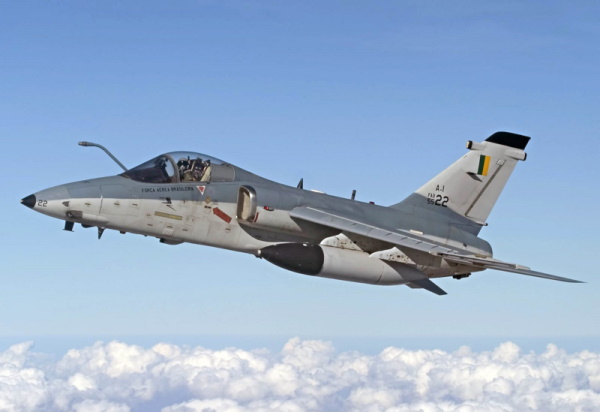
* In late 1953, NATO issued a requirement for a "Light Weight Strike Fighter (LWSF)" for use by NATO member nations. The LWSF was to be a small, simple, cheap, aircraft that could be built in large numbers. It was to be capable of operation from unimproved airstrips, be easy to service and maintain, have built-in armament of four 12.7-millimeter (0.50-caliber) Browning machine guns, or twin 20-millimeter or 30-millimeter automatic cannon, and be powered by the British Bristol Siddeley Orpheus small turbojet.
A half-dozen aircraft firms submitted proposals, with three designs selected for evaluation in 1955: the French Dassault "Mystere XXVI" and Breguet "Taon", plus the Italian Fiat Aviazone "G.91". The initial prototype G.91 was the first of the lot to take to the air, with maiden flight from Caselle airfield in Turin on 9 August 1956, Fiat chief test pilot Riccardo Bignamini. It was powered by the Orpheus 801 engine variant, with 18 kN (1,835 kgp / 4,050 lbf) thrust and was not fitted with armament.
Although the G.91 had a long lead on its competitors, its development program suffered a setback when out-of-control vibration caused the loss of the first prototype on 26 February 1957, Bignamini ejecting safely. A second prototype with modifications such as a shorter tailfin, a raised canopy, a ventral fin, and revised landing gear first flew on 26 July 1957. This machine was powered by an Orpheus 803 turbojet with 21.6 kN (2,200 kgp / 4,850 lbf) thrust, and was armed with four Browning machine guns.
A third prototype was then built, with Fiat moving on to build 27 pre-series / evaluation aircraft. The third prototype and the first pre-series machine were sent to France for participation in the LWSF evaluation. The G.91 was declared the winner in January 1958; there was an intent to acquire the Breguet Taon as well, but it never happened. Although neither of the French contenders would enter production, the Mystere XXVI would lead, indirectly, to the Dassault Etendard naval strike fighter and the Taon would lead, even more indirectly, to the Anglo-French SEPECAT Jaguar strike fighter. Incidentally, Northrop of the US had submitted a design, the "N-156", for the competition that didn't make it into the finals, but would later emerge as the popular F-5 fighter.
The first G.91s were delivered to the Aeronautica Militare Italiana (AMI / Italian Air Force) in 1958. The 27 pre-series aircraft were never really operational machines, though 16 of them were modified to become the mount for the AMI's "Frecce Tricolori" aerobatic demonstration team, with their machines fitted with smoke trail generators and the guns replaced by ballast. These machines were designated "G.91PAN" and "wowed the crowds" until 1982, when they were replaced by the Aermacchi MB.339 trainer.
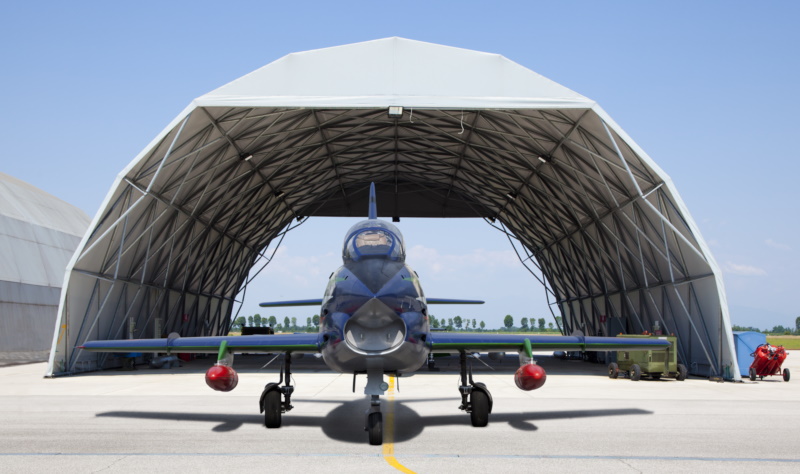
The actual initial service variant of the G.91 was the "G.91R", with the solid nose of the baseline G.91 replaced by a nose with three Vinten cameras. Four pre-production machines were modified to the initial "G.91R/1" subvariant for evaluation; they eventually became part of the set of 16 G.91PAN machines, but 22 G.91R/1 fighters were built new, all going into AMI service, the G.91 ultimately replacing the AMI's US North American / Canadair F-86 Sabres and Republic F-84 Thunderjets. As discussed below, the Luftwaffe would also acquire variants of the "Gina", as it was known, but no other NATO members would obtain the type.
BACK_TO_TOP* The G.91R/1 provides a baseline for the G.91R family. It was the brainchild of a design team under Fiat's Giuseppe Gabrielli. The aircraft was clearly modeled on the US North American F-86K Sabre, license-built by Fiat, though scaled down, with an empty weight about 65% that of the Sabre. Like the Sabre, the G.91R/1 had all swept flight surfaces, with a low-mounted wing featuring 37-degree sweep, plus a conventional tail arrangement, and dual airbrakes forward of the landing gear.
The Gina had tricycle landing gear, all gear assemblies with single wheels, the nose gear retracting backward, the main gear fitted in the inner wings to retract in towards the fuselage. The landing gear was optimized for rough-field operation; the aircraft could fly off of fairly muddy surfaces. Powerplant was a Bristol Siddeley Orpheus 803 turbojet providing 22.2 kN (2,270 kgp / 5,000 lbf) thrust.
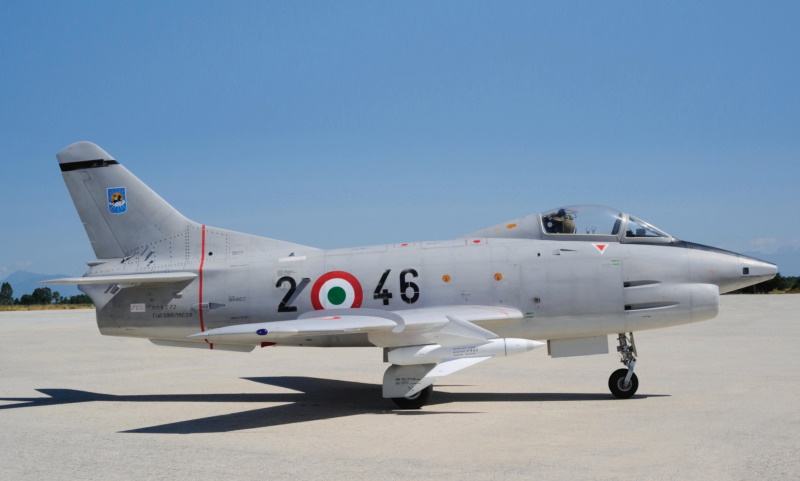
The aircraft was armed with four Browning 12.7-millimeter machine guns, two on each side of the nose, and with 300 rounds of ammunition per gun; the three cameras in the nose were arranged with one shooting forward, and one shooting to each side. The nose cover tilted forward and down for access to the cameras. Initially, there was a single stores pylons under each wing for a total of two, with the pylon on each wing being "wet" for carriage of external fuel tanks. Since the G.91R was intended for service from rough airstrips near the battle lines, fuel tanks were not envisioned as a normal operational store, supposedly only being fitted for ferry flights. Total external load was a modest 680 kilograms (1,500 pounds).
The pilot sat on a Martin-Baker Mark 4 ejection seat under a clamshell canopy hinged to open to the rear. The Mark 4 seat could be fired at zero altitude, but required a minimum speed of 165 KPH (105 MPH / 90 KT) for safe operation. Fiat also developed a comprehensive service kit so mechanics could keep the G.91 flying from rough forward airstrips.
___________________________________________________________________
FIAT G.91R:
___________________________________________________________________
wingspan:
8.56 meters (28 feet 1 inch)
wing area:
16.4 sq_meters (177 sq_feet)
length:
10.3 meters (33 feet 9 inches)
height:
4 meters (13 feet 1 inch)
empty weight:
3,100 kilograms (6,830 pounds)
MTO weight:
5,500 kilograms (12,100 pounds)
max speed at altitude:
1,075 KPH (665 MPH / 580 KT)
service ceiling:
13,100 meters (43,000 feet)
range:
1,150 kilometers (715 MI / 620 NMI)
___________________________________________________________________
The 26 G.91R/1 machines obtained by the AMI were followed by a batch of 25 "G.91R/1A" machines with modestly refined avionics, such as a UHF radio, and then by 50 "G.91R/1B" aircraft with a reinforced airframe, tubeless tires, stronger brakes, and a shell collector system. By the end of 1965, the AMI had two G.91R squadrons ("stormo") dedicated to tactical air support and reconnaissance, plus a maritime strike squadron. In service, they were generally painted in disruptive camouflage colors -- initially in a wrap-around format, later with light blue belly colors. Sometimes the Ginas were painted with sharkmouths or other decorations.
* Fiat also developed a two-seat "G.91T" trainer roughly in parallel with the G.91R, the trainer featuring a fuselage stretch of 140 centimeters (55 inches) to fit a second cockpit, slightly stepped up to give the back-seater a better forward view. Each cockpit had its own clamshell canopy, hinged on the rear. Armament was cut to twin Brownings to reduce weight growth. Initial flight of the first of two G.91T prototypes was on 31 May 1960, with Simeone Marsan at the controls. The AMI would eventually obtain 101 "G.91T/1" trainers.
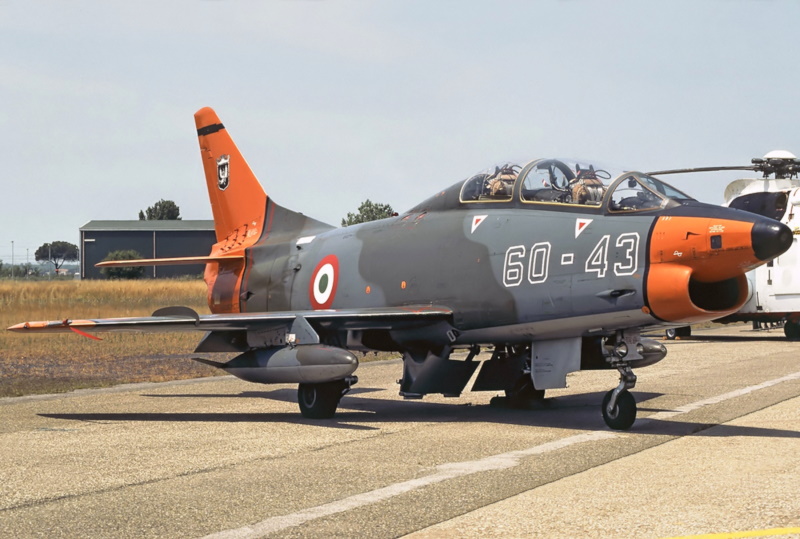
* West Germany placed an order for the Gina in 1958, with the Luftwaffe initially obtaining the "G.91R/3" in 1960. It was generally like the AMI Romeos except for twin 30-millimeter DEFA cannon, with 125 rounds per gun, instead of four Browning machine guns; four stores pylons; airframe reinforcement; and a better avionics kit -- some of that kit migrating back to the AMI G.91R/1B.
The initial batch of 50 G.91R/3 strike fighters was built by Fiat, with the remainder -- as it would turn out, 295 aircraft -- built by a German consortium headed by Dornier. It was the first true combat aircraft built in Germany since World War II. The Luftwaffe G.91Rs were painted in the same color scheme as their Italian brethren. The Luftwaffe also acquired 66 "G.91T/3" trainers, 22 of them built by Fiat, the rest made in Germany. The Luftwaffe trainers were fitted with twin Browning machine guns as were their Italian equivalents, instead of twin DEFA cannon.
* As mentioned above, the idea that the G.91 was to be a "universal" light strike aircraft for NATO didn't pan out. The French placed an order for the Gina early on, but quickly canceled it, preferring to go their own way. The Greeks and the Turks placed orders for the "G.91R/4", a Gina with four Brownings and four stores pylons, but ended up obtaining the Northrop F-5A instead. 50 G.91R/4 machines built for the order ended up in Luftwaffe service instead. A "G.91R/5" for Norway, with enlarged wing tanks for more range, never got off the drawing board.
BACK_TO_TOP* The Italian G.91Rs were generally relegated to training in the 1980s, with the type replaced by the AMX from 1989. The last formal flight of an AMI G.91R was in 1992. The AMI G.91T trainers remained in service until 1995. The Luftwaffe was quicker to get rid of the Gina, phasing out the G.91R/4 in the mid-1960s, and most of the rest of the fleet by 1982, after replacement by the Breguet-Dornier Alpha Jet trainer / light strike aircraft. A few were retained by Condor Flugdienst, a contract arm of the German Lufthansa airlines, as tow target tugs for military training up to 1993.
Early on, both the US Air Force and -- remarkably -- the US Army evaluated the Gina for the tactical strike role. This was apparently a manifestation of an argument over tactical air support between the two services; it seems to have become heated, and certainly the end result was that armed fixed-wing aircraft were declared off-limits to the US Army. Two G.91R machines were loaned to Bristol-Siddeley in the UK for Orpheus engine development work.
Besides Italy and West Germany, the only other nation to fly the Gina was Portugal. Portugal received a batch of 40 G.91R/4 fighters in 1965:1966, the Luftwaffe not having too much enthusiasm for the R/4. From 1976 to 1982, the Portuguese inherited almost a hundred Luftwaffe G.91R/3 fighters and G.91T/3 trainers, though many of them were used as spares hulks. The Portuguese were also the only user to fly the Gina in combat, employing it from 1966 to 1974 in strikes on insurgents in the course of "wars of national liberation" in the Portuguese colonies of Guinea-Bissau, Angola, and Mozambique -- all three of which won their independence, in the wake of the fall of Portugal's authoritarian military government in 1974.
The Portuguese eventually adopted a different paint scheme of tan and green disruptive camouflage topside, with light blue underneath, with a few machines participating in the NATO "Tiger Meet" exercise being given wild tiger colors. Portuguese Ginas were wired for Sidewinder air-to-air missiles (AAM) as well. Portugal withdrew the G.91R/4 from service in the 1980s, finally retiring the last Gina in 1993.
* The service history of the G.91R is nondescript, some sources claiming it was seen as a useful aircraft; others claiming it was disliked; none suggesting any wild enthusiasm for the type. It was said to be underpowered, but that's something of a relative term: the F-86A Sabre had a thrust to empty weight ratio of 0.5, while the ratio for the G.91R was about 0.7. For another standard of comparison, the well-liked Aermacchi MB.326 trainer / light strike aircraft also had a ratio of about 0.5. In addition, the G.91R was very aerodynamically similar to the F-86, which was noted for its good handling, suggesting the G.91R's handling was similar, and it seems its reliability and serviceability were good as well. Overall, it seems to have met the specifications to which it was designed, and its failure to be widely adopted was due to nationalism and politics.
A number of special variants and modifications of the Gina were flown:
Preliminary design work was performed on a supersonic G.91, with a more sharply swept wing and an afterburning Orpheus turbojet, but it never got out of the paper stage. A "G.91T/4" with a new nose housing the NASARR radar for the Lockheed F-104 Starfighter, which flew in AMI service as well as the air forces of many other NATO countries, was also considered but not built.
BACK_TO_TOP* In the mid-1960s, the Italians decided to give the G.91R an "extreme makeover", resulting in the "G.91Y". The "Yankee" looked enough like the "Romeo" to make the two easily confused at a glance, but the G.91Y very significantly differed in being powered by twin General Electric (GE) J85 turbojets, instead of a single Orpheus turbojet.
The AMI issued a requirement for what would become the G.91Y in 1965, with the first of two prototypes performing its initial flight on 27 December 1966. Initial flight of a production machine was in July 1968, with deliveries to the AMI beginning in 1970, by which time Fiat Aircraft had become Aeritalia.
Along with the twin J85-GE-13A turbojets, providing 18.15 kN (1,850 kgp / 4,080 lbf) afterburning thrust each -- with distinctive auxiliary intakes on top of the rear fuselage -- the Yankee featured other changes relative to the Romeo, such as structural changes and reinforced landing gear to accommodate the twin jets, and deal with the substantially increased empty weight. It also had leading-edge maneuvering slats to improve take-off and landing performance as well as combat agility, plus a stretched wing with 10% more wing area.
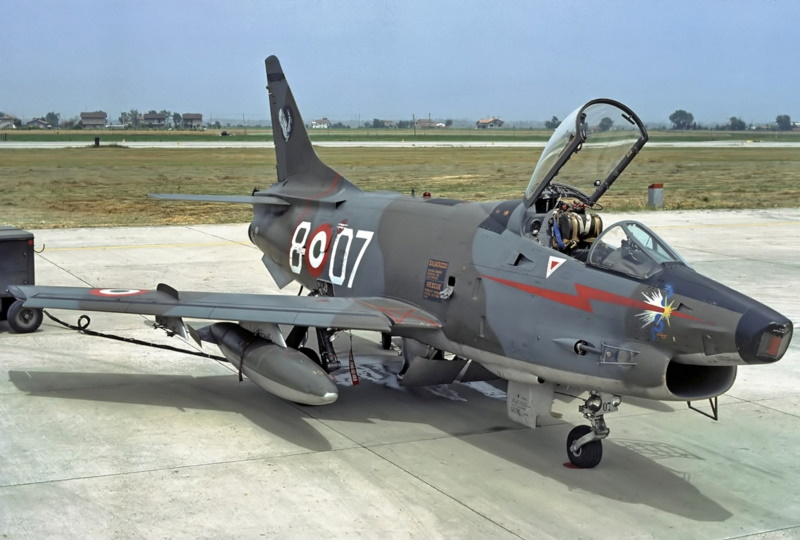
The Yankee was armed with twin 30-millimeter cannon and had four stores pylons, like the Luftwaffe G.91R/3 fighters. The camera nose was slightly shorter than that of the G.91R, giving the G.91Y a somewhat "pig-snouted" appearance. Avionics were generally modernized, the aircraft featuring a new navigation-attack system, with a "head-up display (HUD)" connected to the flight computer to provide more precise targeting. The pilot sat on a Martin-Baker "zero-zero" (zero speed zero altitude) rocket-boosted ejection seat.
___________________________________________________________________
FIAT G.91Y:
___________________________________________________________________
wingspan:
9.01 meters (29 feet 6 inches)
wing area:
18.13 sq_meters (195.2 sq_feet)
length:
11.67 meters (38 feet 4 inches)
height:
4.43 meters (14 feet 6 inches)
empty weight:
3,900 kilograms (8,600 pounds)
MTO weight:
8,700 kilograms (17,195 pounds)
max speed at altitude:
1,110 KPH (690 MPH / 600 KT)
service ceiling:
12,500 meters (41,000 feet)
range with tanks:
3,400 kilometers (2,110 MI / 1,835 NMI)
___________________________________________________________________
67 "Yankees" were built, including the two prototypes. The AMI was never completely happy with the Yankee, as demonstrated by the fact that the Romeo remained in service alongside it -- though that was also a function of budget limitations. While a more formidable machine than the Romeo on paper, some sources claim that the Yankee wasn't much more capable, and the twin engines were a maintenance headache. The G.91Y was scheduled to be retired from the mid-1980s as its replacement, the AMX, came into service, but due to delays in the AMX program, the Yankee wasn't actually put out to pasture until 1994.
A trainer version was considered, as was a "G.91YS" for a Swiss requirement, with this machine featuring various tweaks, most notably a third stores pylon outboard on each wing for carriage of a Sidewinder AAM and a nose with a laser rangefinder. The Swiss obtained the Northrop F-5F instead. The Yankee was never operated by a foreign air arm.
* A total of 757 G.91s of all types was produced. The list below gives G.91 variants and production:
* In June 1977, the AMI issued a request for a replacement for the Fiat G.91R/Y and Lockheed F-104G/S fighters in the strike and reconnaissance roles. Italy was part of the international Tornado Multirole Combat Aircraft effort, but the AMI wanted a smaller and cheaper machine to complement the service's future Tornado fleet. The Aeritalia (later Alenia) firm had been working on concepts since 1973; in response to the AMI request, in April 1978 Aeritalia joined forces with Aermacchi to work on the requirement, which was given the designation of "Aeritalia Macchi Experimental (AMX)".
The Forca Aerea Brasileira (FAB / Brazilian Air Force) was also interested in a new light tactical aircraft. After discussions between Italy and Brazil, an agreement on a joint specification was inked in March 1981, and in July 1981 the Brazilian government-backed firm Embraer joined the AMX effort. Aeritalia's workshare was 23.6%, while Aermacchi's was 46.5% and Embraer's was 29.7%. Although there was a division of labor between the three companies in construction of subassemblies, all three were to perform final assembly.
Initial flight of the first AMX prototype was on 15 May 1984, with Manlio Quarantelli at the controls. The prototype crashed on 1 June, Quarantelli ejecting but dying of his injuries. The second prototype performed its first flight on 19 November 1984 and took over the test and trials program. The Italians built three more prototypes and Embraer built two, for a total of seven. Production went ahead in 1986.
The first production machine, for the AMI, performed its initial flight on 11 May 1988; the first Brazilian production machine performed its initial flight on 12 August 1989. Service entry into both the AMI and FAB was in 1989, with the type designated "A-1" in Brazilian service. The manufacturing group claimed the AMX could carry half the warload of the Tornado over 40% of the combat radius, at a quarter of the price. This assessment didn't factor in the Tornado's much greater sophistication, but the AMX still provided a useful complement to the AMI Tornado force, and was a highly cost-effective weapon for the FAB.
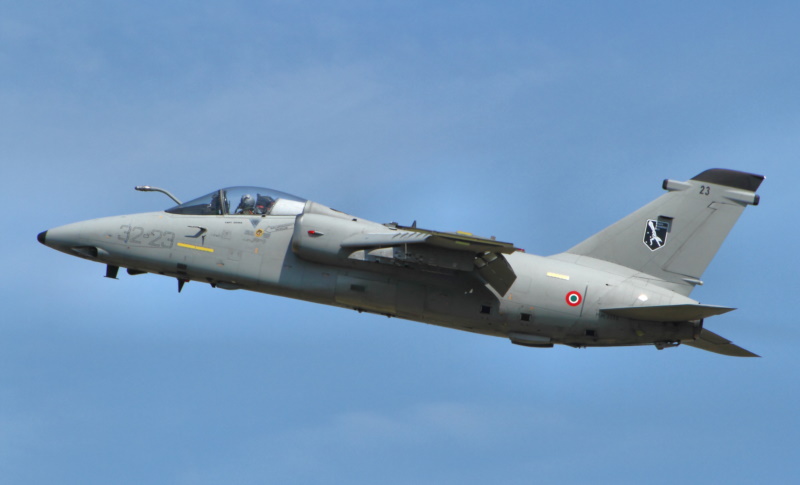
Work on a two-seater, the "AMX-T", began in 1986, with Embraer performing the "heavy lifting" on the redesign. Initial flight of the first of three AMX-T prototypes was on 14 March 1990. It was given the designation of "A-1B" in FAB service. From 2012, the AMI designated the AMX the "A-11A", with the AMX-T becoming the "A-11B"; the type was known as the "Ghibli", after a desert wind of North Africa.
BACK_TO_TOP* The AMX emerged as a simple but capable design, clean in appearance. It was built mostly of aviation aluminum, except for a carbon composite tailfin and elevators. Flight surfaces included a shoulder-mounted trapezoidal swept wing, featuring a leading-edge sweep of 31 degrees, and swept tail surfaces. The wings were fitted with full-span leading-edge flaps; dual double slotted trailing-edge flaps inboard of the ailerons; and dual spoilers on top of each wing that could be used as airbrakes. The flap arrangement gave good short field performance, with the AMX capable of getting off the ground in less than a kilometer at MTO weight. The tailplane was all-moving, but also had small elevator surfaces to improve control authority.
All controls were hydraulically actuated, using a dual redundant hydraulic system to ensure combat survivability; the AMX was designed with considerable redundancy to make sure it could get back home after a mission. Built-in self-test systems and modular design helped ensure rapid repair and quick turnaround.
The AMX was powered by a Rolls-Royce low-bypass non-afterburning Spey RB.168 Mark 807 turbofan providing 49.1 kN (5,000 kgp / 11,030 lbf) thrust, license built by a collaboration of Fiat, Piaggio, and Alfa-Romero in Italy and by Companhia Eletro-Macanica (CELMA) in Brazil. The Spey RB168 Mark 807 was a hybrid of the Spey Mark 101 used on the British Buccaneer strike aircraft and the civilian RB.183 used on the Fokker F28 Fellowship airliner. Trials were conducted with an AMX fitted with the more powerful RB.169 Mark 821, providing 58.4 kN (5,950 kgp / 13,125 lbf) thrust, as a possible growth path.
A Fiat FA 150 Argo auxiliary power unit (APU) was fitted for engine self-starting and ground power. There were two self-sealing rubber bag fuel tanks in the fuselage and an integral tank in each wing, providing a total internal fuel capacity of 3,500 liters (923 US gallons), with single-point refueling. An inflight refueling probe could be bolted onto the right side of the nose.
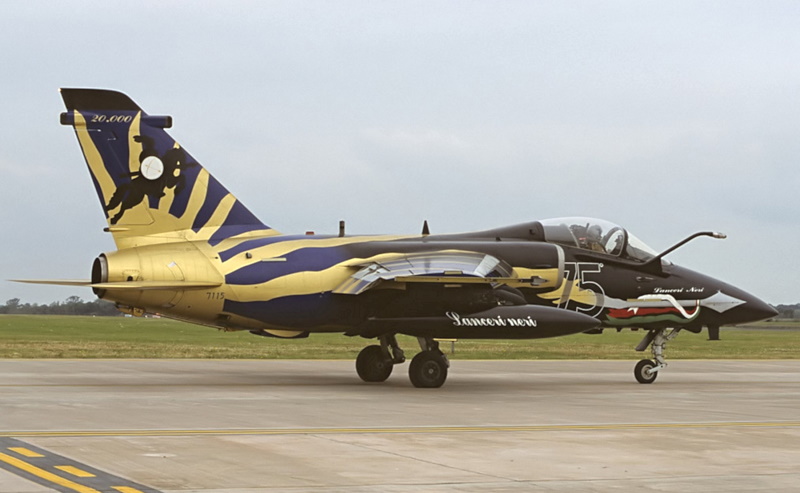
The hydraulically actuated tricycle landing gear, designed for rough-field operation, featured single wheels with low-pressure tires on each gear assembly. The steerable nose gear retracted forward into the nose, while the main gear retracted forward into the fuselage under the engine intakes, with the wheels turning 90 degrees to lie flat. There was no brake chute, with the flap arrangement and the spoiler / airbrake system permitting a landing roll of no more than 500 meters (1,640 feet). A runway arresting hook was fitted under the tail.
The pilot sat in a pressurized and climate-conditioned cockpit on a Martin Baker Mark 10L "zero-zero" (zero speed / zero altitude) ejection seat, under a two-piece canopy that hinged open to the right side. The pilot flew the aircraft with "hands on throttle & stick (HOTAS)" controls, using an OMI/Selenia head-up display (HUD) and a single Alenia head-down multifunction display (MFD), with the MFD providing a map display or imagery from weapon seeker or targeting pod; all other controls were analog gauges and dials.
The AMI AMX and FAB A-1 were given different avionics suites. The original avionics for the AMI machine -- avionics were later updated, see below -- included:
The FAB A-1 differed from the AMI AMX in having a simpler navigation system, consisting of a VOR / ILS beacon navigation / landing system, and a FIAR-Techtelcom SCP/01 radar. In either case, avionics were modular for easy replacement.
AMI AMX machines were fitted with internal armament of a General Electric M61A2 Vulcan 20-millimeter six-barreled Gatling cannon with 350 rounds and firing out the left side of the nose, while the FAB A-1 was fitted with twin DEFA 554 30-millimeter revolver-type cannon firing out both sides of the nose. Apparently the FAB did want the Vulcan, but the US would not approve it for export to Brazil.
There were two stores pylons under each wing, a centerline pylon, and wingtip launch rails for Sidewinder or Brazilian MAA-1 Piranha AAMs, for a total of seven stores attachments. The centerline and inboard pylons were stressed for 900-kilogram (2,000-pound) loads, while the outboard pylons were stressed for 450-kilogram (1,000-pound) loads. All four wing outboard pylons, but not the centerline pylon, were "wet" for carriage of external fuel tanks. Total external payload was 3,800 kilograms (8,340 pounds). Dual and triple stores adapters were available, but the triple adapter could not be carried on the outer wing pylons.
___________________________________________________________________
ALENIA-AERMACCHI-EMBRAER AMX:
___________________________________________________________________
wingspan (with rails):
9.97 meters (32 feet 8 inches)
wing area:
21.0 sq_meters (226 sq_feet)
length:
13.23 meters (43 feet 5 inches)
height:
4.55 meters (14 feet 11 inches)
empty weight:
6,730 kilograms (14,835 pounds)
MTO weight:
13,000 kilograms (28,660 pounds)
max speed at altitude:
940 KPH (585 MPH / 510 KT)
service ceiling:
13,000 meters (42,650 feet)
range (typical):
1,850 kilometers (1,150 MI / 1,000 NMI)
___________________________________________________________________
Typical external stores included iron bombs, cluster munitions, unguided rocket pods, and external fuel tanks. There were two types of tanks: a 1,100-liter (264 US gallon) tank that could only be carried on the inboard pylons, and a 580-liter (153 US gallon) tank that could be carried on all of the wing pylons.
The AMX could carry laser-guided bombs (LGBs). It appears that it wasn't qualified for a targeting pod early on, with the LGBs designated by ground forces or other aircraft. Italian AMX machines could carry guided bombs with Israel Opher guidance kits; these munitions looked like laser-guided bombs, but they were actually infrared imaging weapons.
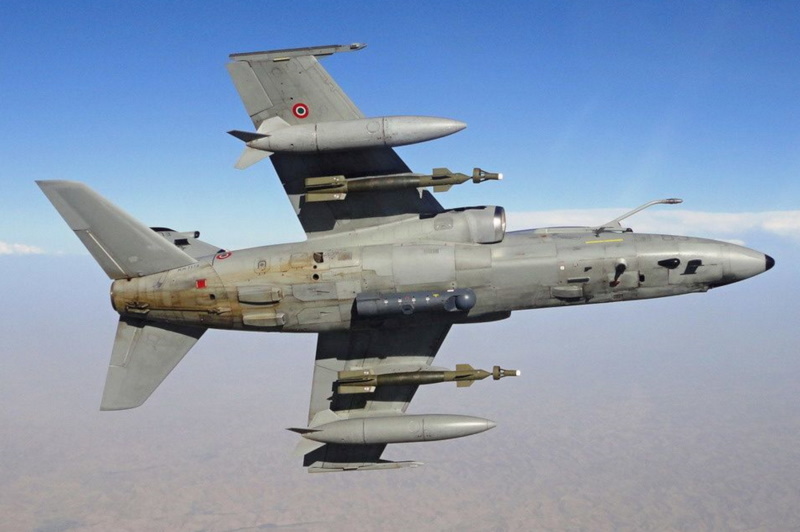
One AMX-T was fitted with the more advanced FIAR Grifo multimode radar and used for trials with the Aerospatiale AM39 Exocet antiship missile in the early 1990s. The Italian Marte antiship missile was also evaluated, presumably by the same aircraft. Sources claim the German Kormoran antiship missile could be carried as well, but that seems to have been a potential store. A stock AMX had no capability to carry a proper antiship missile.
The AMX could carry a centerline reconnaissance pod, originally the Oude Delft Orpheus infrared linescan pod, inherited from Italy's old Starfighter fleet. The Brazilians obtained an "AMX-R" reconnaissance variant that could be fitted with reconnaissance pallets in a dedicated bay, just forward of the main landing gear on the right side; the FAB designated them "RA-1". Although the RA-1s could carry underwing stores, it is unclear if they retained the twin DEFA cannon.
* The AMX-T had the same dimensions as the AMX, with the second seat accommodated by removing one fuselage fuel tank and rearranging the environmental control system. It was primarily intended as an advanced / operational trainer and had dual controls, but it remained fully combat-capable. The rear seat in the AMX-T was raised to give the instructor in the back seat a better forward view. There was a GEC HUD repeater display for the back-seater.
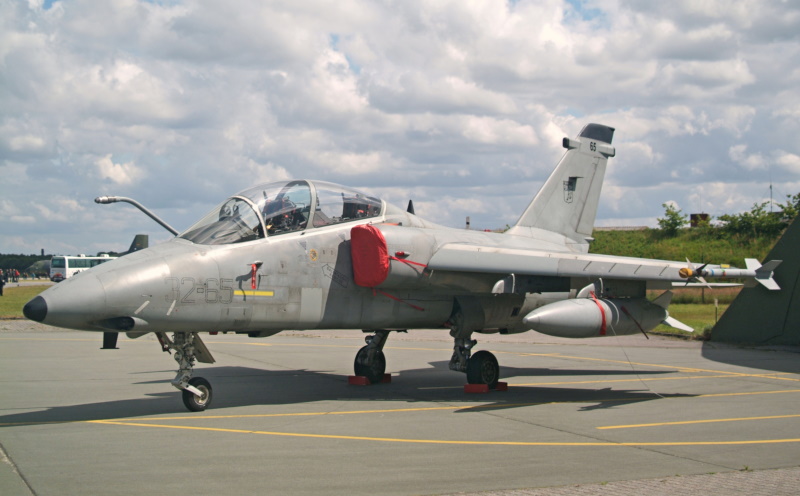
An "AMX-E" electronic warfare variant, based on the AMX-T, was considered. It would have featured jamming gear to provide electronic escort for strike aircraft, and also emitter targeting gear and AGM-88 HARM anti-radar missiles to take a more assertive approach to dealing with adversary defenses. The idea never got beyond the paper stage.
BACK_TO_TOP* The last AMI single-seater was delivered in 1997, and the last Italian two-seater was delivered in 1998. Brazilian production was completed in 1999. Not counting prototypes, the AMI obtained a total of 110 single-seaters and 26 two-seaters, while the FAB obtained 45 single-seaters -- including 15 RA-1 reconnaissance machines -- and 11 two-seaters. The machine apparently proved highly satisfactory in service, with pilots enjoying its good handling and excellent cockpit field of view, and service crews happy with its maintainability.
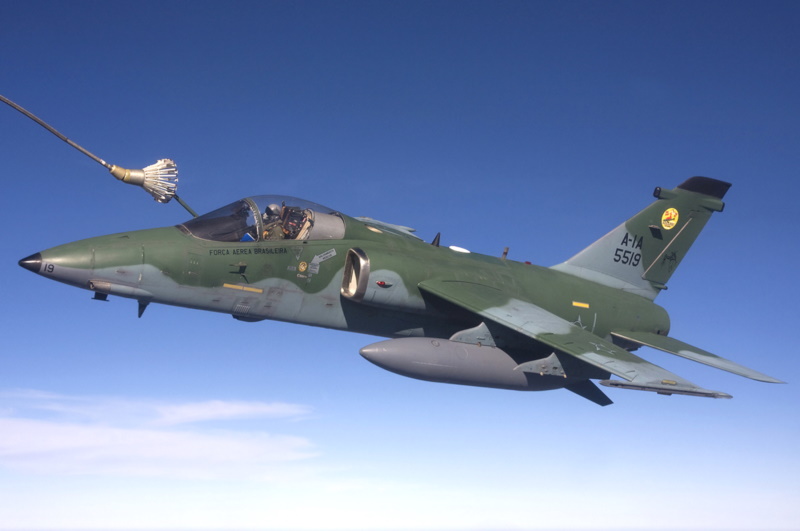
The AMX fleet was grounded in 1992 and 1996 due to engine failures, but those problems were resolved. The AMX saw combat service with the AMI during the wars of the Balkan Succession, flying in Operation DELIBERATE FORCE in 1995 and Operation ALLIED FORCE in 1999; they used Opher infrared-guided bombs. From 2009 to 2014, the AMX was used for reconnaissance missions over Afghanistan, with the AMX also performing strikes during the NATO intervention in Libya in 2011.
Although Thailand ordered a large batch of AMX fighters in the early 1990s, funding cutbacks led to the cancellation of the order. Venezuela ordered eight two-seaters and four options in 1999, though contract negotiations dragged out -- and finally the US government, annoyed with the anti-American agitation of Venezuelan strongman Hugo Chavez, torpedoed the sale. The Venezuelan machines were to be built to an improved standard, with the designation of "AMX Advanced Attack Trainer (AMX-ATA)", featuring modernized avionics; a forward-looking infrared (FLIR) imager; a new Elta EL/M-2032 multimode radar that included antiship and air-to-air combat modes; and a helmet-mounted sight.
Both Italy and Brazil upgraded their aircraft. It seems the original plan was for both nations to adopt a common upgrade standard, but that plan proved too ambitious and more limited upgrades were pursued. The AMI upgrade program, designated "ACOL", was formally initiated in early 2005, with 55 machines to be upgraded by Alenia Aeronautica. The upgrade replaced the original INS with an INS, backed by a Global Positioning System receiver; add color MFDs; as well as update communications and IFF. Addition of a GPS capability allowed the AMX to carry GPS-guided munitions.
Initial flight of an upgraded AMX was in September 2005, with initial redelivery to the AMI in March 2007, and final redelivery in 2012. The single-seaters were designated "A-11B", while the two-seaters were designated "TA-11B". The AMI obtained Rafael Litening targeting pods and RecceLite reconnaissance pods for the updated AMX fleet. There was thought of another upgrade, but the AMX was retired in 2024, with the Eurofighter Typhoon taking up the strike role on an interim basis, and the Lockheed Martin F-35 to be the ultimate replacement.
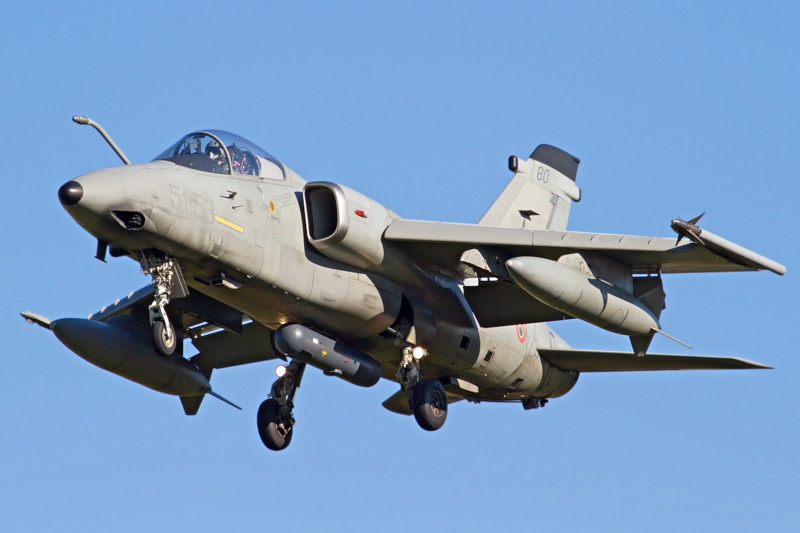
The FAB had been pushing for an upgrade from 2004, but due to funding cutbacks the first aircraft to be upgraded wasn't handed over to Embraer until August 2007. 43 machines were to be upgraded to "A-1M" spec with as SCP-1 Scipio multimode radar; HOTAS controls; cockpit compatible with night vision devices, as well as fitted with a new HUD and three color MFDs; a fixed forward looking infrared (FLIR) imager alongside the nose; datalink and flight data recorder; new countermeasures systems; new communications / navigation kit; and compatibility with the latest guided weapons. The avionics system was obtained from Elbit of Israel.
The FAB also obtained Litening targeting pods and RecceLite reconnaissance pods. Initial flight of the A-1M was in 2012, with initial re-delivery in 2013. However, re-deliveries were slow, and in 2016 budget cuts forced the suspension of the program. Some sources hint that it was restarted, but in any case, Brazil's AMX machines are to be replaced by the SAAB JAS-39 Gripen fighter by 2032.
BACK_TO_TOP* Sources include:
Some materials were taken off the Air Force Technology and Flug Revue websites, as well as a number of editions of JANE'S ALL THE WORLD AIRCRAFT.
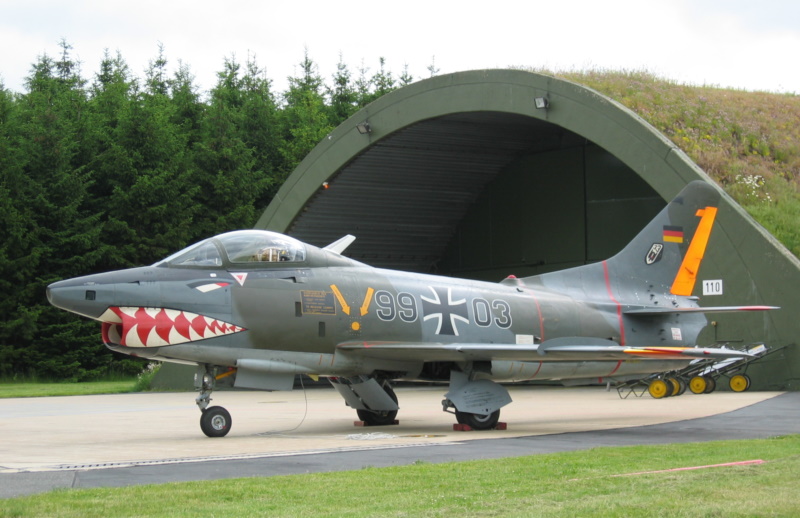
* Illustrations details:
* Revision history:
v1.0.0 / 01 mar 05 / Originally only discussed AMX. v1.0.1 / 01 feb 07 / Review & polish. v1.0.2 / 01 feb 09 / Review & polish. v1.0.3 / 01 dec 10 / Review & polish. v2.0.0 / 01 nov 12 / Added G.91. v2.0.1 / 01 oct 14 / Review & polish. v2.1.0 / 01 sep 16 / Review & polish. v2.1.1 / 01 aug 18 / Review & polish. v2.2.0 / 01 jul 20 / Review & polish, illustrations update. v2.2.1 / 01 may 22 / Review & polish. v2.2.2 / 01 apr 24 / Review & polish. (+)BACK_TO_TOP
